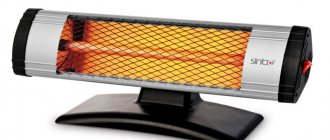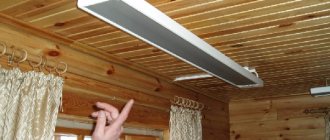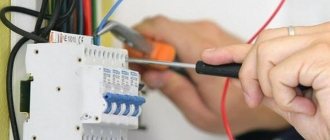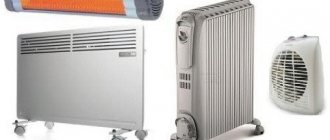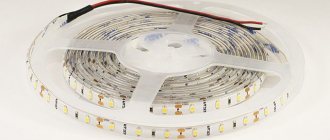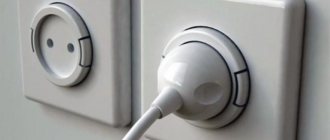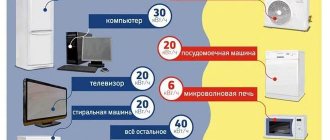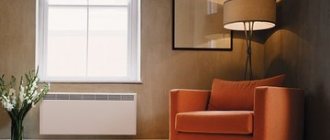Electricity consumption
To calculate how many kilowatts a heater consumes, you need to make simple calculations that any user can do.
Does this or that heater consume a lot of electricity? Let's count. Let's take a device with a power of 2 kW or two thousand watts as an example. For an hour of operation, it consumes two kilowatts. Let's imagine that on cold days the heater works eight hours a day, after an hour of operation there is a break for two hours. Sixteen kilowatts are consumed per day. The number was obtained by multiplying the number of working hours by the consumption per hour. The monetary equivalent is calculated simply: the price per kilowatt is multiplied by the number of kilowatts spent. Consumption amounts vary depending on the intensity of use of the device.
The data obtained helps to easily calculate how much electricity is spent per month throughout the cold season. The indicators depend on weather conditions, how often and for how long the heater operates. If we imagine that a particular month was very cold and the device heated the room every day for eight hours, the electricity consumption per month would be four hundred and eighty kilowatts.
To pay the minimum, you need to use climate control technology rationally. Buying a high-quality and suitable heater will allow you to organize minimal electricity consumption, which means it won’t hurt your wallet.
The use of any heating device will result in increased electricity consumption. To ensure that the increase in costs is insignificant, you need to find out in advance basic information about different types of heaters and choose a device with a high-quality thermostat. It is designed to set precise temperature conditions, regulate the operation of the device: turn it on and off, increase and decrease power.
The best option to optimize the process is to purchase a heater with a thermostat or thermostat. If necessary, the timer can be purchased separately.
Traditional heaters that are not equipped with temperature controllers are not the most convenient to use: they must be turned on and off independently depending on the air temperature. It also prevents the room from being preheated before family members arrive.
To eliminate a host of problems and potential dangers, you can purchase a thermostat for your heater.
It will help set the cycle, mode and power of the heating device. The use of thermostats allows you to optimize the heating process due to their functional features:
- You can independently set the desired temperature;
- devices automatically regulate the switching on and off of heating equipment;
- the heater turns on only when the temperature drops to the specified temperature, so it is possible to regulate electricity consumption and normalize the process of resource consumption;
- You can independently control the microclimate in the room, preventing the air from drying out.
Electronic, electromechanical thermostats and thermostats for infrared heaters are available for sale. GSM and WI-FI adjustable controllers have appeared.
Having equipped a thermostat, you begin to independently control the consumption of electrical energy - this is the main advantage of the device. Installing a thermostat has many advantages:
- function of automatically reducing the network load by fifty percent;
- full heating even with reduced network load;
- the ability to control every kilowatt of electricity;
- setting individual temperature conditions for any room;
- daily and weekly cycle programming;
- ease of operation;
- no clicks when changing operating mode.
The thermostat can be installed at a distance from the heater, on its surface or inside the device.
Economical electric heaters of a new generation
In modern stores you can find a large number of economical electric heaters of the new generation. All of them have a number of advantages, thanks to which they have become so popular.
Advantages of these types:
- The main advantage is energy savings - this is the main indicator by which users choose equipment. Equipment costs are lower. The remaining parameters, although significant, have a secondary role.
- It is also necessary to note the double insulation system, which is very often installed in equipment.
- The appearance of the device is ergonomic and looks quite elegant. But it is also possible to find more decorative samples, with the help of which owners also decorate their apartments or private houses. Customers also have a choice of different colors of heaters. This is extremely useful if you need to place the device under a certain design.
- Since natural convection is used to heat the room, the equipment operates almost silently.
- During operation, oxygen will not be burned, and various unpleasant odors will not be formed. These are important characteristics that attract buyers.
- In more expensive energy-saving heaters, protection is installed to protect the device from overheating and power surges. This is especially true for residents of private houses, where power outages occur much more often than in apartments.
- Modern models are equipped with high-quality heating elements that are capable of warming up rooms several times higher than analogues from previous years.
- There is also no need to worry about burns, since the front surface of the device does not heat up. This is very important if the heater is installed in a children's room.
- Modern heating devices are equipped with a precise thermostat that operates electronically. This is also an extremely convenient component with which you can monitor the resulting temperature and control the heating process of the room.
- Manufacturers claim that continuous operation of the device can be effective for 30 years.
Previous models of heaters consumed quite a large amount of electricity. The old models, which were connected to the electrical network, did not even have a thermostat, and therefore there was no way to regulate the power. This suggests that all models were operating at their limits, thereby consuming large amounts of energy. Then heaters with stepwise power changes appeared, and later manufacturers invented special sensors with which they could regulate the temperature independently. This gradual evolution of heating machines has led to the release of modern energy-saving devices.
Heater NOBO Viking C4N 10 in the interior
Nowadays, a new generation of heaters has begun to go on sale, which consume a small amount of electricity, but at the same time retain all their functionality. For example, this technology is successfully implemented by the Nobo company, which has been manufacturing convectors for almost 100 years.
To understand which heaters it is advisable to purchase for your home in order to save money on electricity, you need to familiarize yourself with the most popular models.
Quartz
The heating element of quartz heaters is a lamp, very similar to an ordinary tube. It is covered on top with a metal casing for protection. This version of the heater does not heat the space, but certain objects, as well as the area. To work effectively, you only need to correctly point the equipment in the right direction.
Modern models are very effective in terms of heating rooms and that is why they are becoming so popular. If you want to purchase the most economical version of such a device, you need to pay special attention to the design of the lamp. If halogen types are installed, much more electricity will be consumed than in other options.
Infrared quartz heaters manufactured in film form are available for sale. They are placed directly into the floor or walls. It is important to note that even when the equipment is turned off, heat will continue to flow into the room for a long time
Advantages:
- Can be used in absolutely any room.
- Low amount of electricity consumption.
- The case heats up very little.
- The equipment quickly heats up to the required temperature, and then effectively distributes heat throughout the room.
- During work, a person does not notice various unpleasant odors, since they are simply absent.
- The equipment is durable and extremely reliable.
The disadvantages of the heater include its not too small dimensions.
Ceramic
Ceramic device models are also economical in terms of power consumption. These models began to go on sale quite recently, but since they are highly effective, they became popular almost immediately among consumers.
Part of the equipment:
- Monolithic body.
- Elements made of ceramics.
- A cable with high heat resistance that acts as a heating element.
A distinctive feature of the equipment is the combination of several heating options:
- Infrared.
- Convection.
With the help of such a system, you can warm up the entire room in a short time. The heat inside the object spreads very evenly and smoothly.
Ceramic heater
Advantages:
- The heater can be installed in any type of room.
- Absolutely safe for human and animal health.
- Ceramic panel consumption – 370 W. It consumes no more electricity than a simple TV.
- There is automatic control.
- The equipment is completely safe for children, as there are built-in safety elements.
- The heater will last a long time.
- Easy to use.
Oily
The oil type of equipment is considered one of the most popular. These models are called radiators. Inside the device there is a liquid that is heated. This is a heating element. The technical characteristics of the oil type are at the highest level. During use, no unpleasant odors are formed, and the device can be used for a very long time.
Mobile and stationary models are available.
Advantages:
- To connect equipment inside the house, you do not need to call a trained specialist.
- The price for the heater is low.
- The equipment will maintain the resulting temperature in the room for a long time.
- Automatic shutdown is built in, and therefore electricity consumption is sharply reduced.
Infrared
Infrared equipment provides directed heating; the device not only saves energy, but it can be placed in almost any plane: on a wall, an inclined surface, ceilings. The price for the equipment is also quite low.
Infrared heater
The number of heaters may vary.
Micathermic
Micathermic heaters are a type of infrared heater because heat is distributed through radiation. The equipment is covered with a special coating that is beneficial to humans.
How much does an infrared heater consume 2 types of device
There is a room of 17 m2 and central heating, which maintains a room temperature of 20 degrees. What will be the daily energy consumption if I use a convector to increase the temperature in the room to 25 degrees?
I would really like to know about detergents and cleaning products for the most common surfaces, such as a bathtub, toilet, kitchen, microwave... and cleaning products, the cheapest, the most expensive, and the middle???
The oil cooler is self-sufficient. Depending on the volume, the warm-up time may vary. But after the device is in operating mode, it shows excellent characteristics of economy and efficiency. The heating elements are turned on for a short time, the radiator almost always has the same temperature.
The clear winner was the convection heater: maximum heat for average money. The only limiting factor is the price.
Oil radiator
The classic type of heater and the slowest, in my opinion.
Principle of operation:
- First, the filler (oil) is heated by means of a hidden heating element or spiral;
- then the case warms up;
- After this, the heat begins to spread into the environment.
That is, an oil fireplace heats the air, but the walls, floor and objects around remain cold. In addition, the device needs time - and a lot - to heat the case. Typically, such devices have a power of 1-2.5 kW and are not economical. Suitable for use in small rooms with a closed door. I wouldn’t buy such a heater for a home, but it belongs in an office. The advantage of such devices is that you can dry things on them, which is very convenient if you commute to work on a rainy day. The big disadvantage is that the oil cooler is short-lived; the older the model, the more dangerous it is due to the fact that oil can leak out and cause a fire or burn.
Conclusion: oil-based devices are inferior to other types of heaters in terms of efficiency, performance and safety.
Which heater consumes less electricity for a summer house and other homes?
Based on many experiments, we can single out one type that consumes less electricity. Such a device is a convector. The operating principle is similar to an oil radiator, but is distinguished by its safety and modernity.
Air circulates through the heating element, which is located in the convector. Thus, heat exchange occurs. The convector can be left on for a long time unattended, as it is one of the safest devices.
Such heating equipment is ideal for a country house. It does not dry the air, and the heating temperature cannot exceed 60 o C. After turning on the convector, the room will begin to heat up in 20 minutes. It consumes 25% less electricity than other heating devices.
How much electricity can household electrical appliances consume?
1. Computer
Calculations that will show how much electricity a computer consumes will be carried out approximately, since everything depends on the power of your computer’s power supply and the specific work that the computer is performing at the moment.
For example, if the power of a computer unit is from 350 to 550 Watts, it is unlikely to consume all the power even under full load. It is also necessary to take into account the monitor - from 60 to 100 watts. In total, with an average computer power supply of 450 Watts and a monitor of 100 Watts, you get 550 Watts or 0.55 kW of electricity per hour. This figure is greatly overestimated. For an approximate calculation, you can take the maximum value - 0.5 kW/h. Thus, when using a computer 4 hours a day, the result is 60 kW/h per month. (0.5*4*30). Now you can build on these numbers, for example, when using a computer 8 hours a day, we get 120 kW/h. per month.
2. Refrigerator
The technical data sheet for the refrigerator indicates the annual electricity consumption. Basically, this figure ranges from 230 to 450 kW/h. Dividing this value by 12, we get from 20 to 38 kW/h of electricity consumption per month. This indicator is applicable only for ideal conditions. The amount of power consumed depends on the volume of the refrigerator and the number of products in it. It is also necessary to take into account external conditions depending on the time of year.
3. TV
TVs are different. On average, for calculation, we will take 100 Wh. For example, when watching TV you spend 5 hours a day - 0.5 kWh. Per month - about 15 kW/h. LCD TVs with large screen diagonals consume 200-50 W per hour. Screen brightness also plays an important role. Accordingly, we calmly multiply the number of kilowatt-hours spent per month by 1.5. It turns out to be about 23 kW/h, but this is an average value, do not forget about it. Large plasma TVs consume between 300 and 500 watts per hour. If you have several different TVs in your apartment, add up the values.
4. Washing machine
To determine how much electricity a washing machine consumes, you need to know the washing mode, the weight of the laundry and the type of material. On average, the power will range from 2 to 2.5 kW/h. However, it is rare for machines to consume this amount of electricity. For calculations, you can take from 1 to 1.5 kW/h. When washing 2 times a week for 2 hours, we get from 16 to 24 kW/h.
5. Kettle and iron
The biggest energy consumers in an apartment are the kettle and iron. Operating for a minimum amount of time, they consume the same amount of electricity as some appliances per month. With a kettle power of 1.5 to 2.5 kW/h, using it 4 times a day for 5 minutes, we get from 20 to 25 kW/h per month. It's a similar story with the iron. Its power is approximately the same as that of a kettle; if you iron it 3 times a week for 1 hour, you get from 25 to 30 kW/h per month.
Not all appliances that consume electricity are listed here; they also include microwave ovens, vacuum cleaners, phone chargers and laptops. You also need to take into account incandescent lamps, which, depending on their number, power and operating time, can consume from 50 to 100 kW/h of electricity per month.
As a result, through such calculations, we obtain an approximate electricity consumption that will range from 200 to 300 kW/h per month.
Many people have heard that increased electricity bills are entirely your fault. Either you sit at the computer a lot, or you watch TV for too long, and you also iron and wash too often. But let's try to figure out how much electricity household electrical appliances can consume.
How much electricity does a fan heater consume?
The fan can be turned off, but then the heating effect of the device is small. In addition, this will lead to rapid burnout of the coil, since it is not cooled, which is dangerous due to fire.
In order to understand how much electricity your heater will consume, first of all, you need to pay attention to the factory characteristics, depending on the power consumption there will be a corresponding electricity consumption. Also, everything will depend on the operating mode of the device; if it operates in maximum mode, then the consumption is greater, if in minimum mode, then less.
What affects the electricity consumption of a fan heater?
Fan heaters are one of the most popular types of heaters. This is influenced by its compactness and the fact that it quickly heats the room. They are easy to carry, easy to use and transport. No special tools are required for their installation.
There are several types of fan heaters, which we will consider. Their electricity consumption depends on the model, manufacturer’s power, and purpose.
Based on the types and design, they can be divided into types:
- fan heaters with regulator;
- fan heaters with regulator and thermostat;
- fan heaters for quickly heating large rooms.
Fan heaters with a regulator have several powers and operate depending on the one set. For example, in position 1 it works with a power consumption of 500 W, in position 2–1000 W, and in position 3–1500 W. Modern models may have more power control positions. The main disadvantage is that constant supervision is required both over the time it takes to switch power, and so that it does not overheat. Nevertheless, it makes it possible to accurately calculate energy consumption.
Fan heaters with a regulator and thermostat are a more complex design. It provides for disconnecting the device from the network in case of overheating. Therefore, there is no need to constantly monitor him. You can turn it on and go about your business. The built-in thermostat allows you to turn off the heater when the desired temperature is reached in the room. To do this, it is enough to catch the moment of the temperature that we need and record it on the thermostat. Its energy consumption depends on various factors, primarily on the temperature to which the room must be heated and then maintained at this temperature. It is clear that the greater the difference between the initial temperature and the required one, the more electricity will be needed. Allows you to select several powers, as well as several fan operating modes.
Important! Fan heaters require normal air circulation to operate! Therefore, you should try to install the device in places where this can be done. Do not place close to walls, furniture, or work tables
In addition to the fact that if there is insufficient air circulation, the heating of the room will be less, and therefore the electricity consumption will be greater, this can lead to overheating of the coil and its fire.
The heat gun fan heater is used to quickly heat large rooms. For example, clubs, discos, conference rooms, such rooms where people do not always gather and there is no need for constant heating.
If compared with a convector of the same power, the convector will heat the room in 30 minutes, and such a fan in 10. The difference is three times. But it consumes a significant amount of electricity and is completely unsuitable for domestic needs. Heating will cost too much.
Example of calculating electricity consumption
Let's try to calculate the maximum electricity consumption of the device. If the factory specifications indicate that its power is 2000 W, this means that it will consume 2 kW per hour of operation in maximum mode. In winter, the approximate operating mode is as follows: an hour is on, and 2 is off. Therefore, there will be 8 hours of work per day.
2*8 and we get 16 kW of energy per day. If the average price for electricity is 4 rubles, then it turns out that heating the room for a day will cost you 64 rubles. These are the numbers for the maximum mode. In economic regimes, of course, the cost will be lower.
Thus, knowing the power of the fan heater and the approximate operating time, we calculate the cost of heating.
Which heater is the most energy efficient?
Before the start of the heating season, it is worth considering in advance which equipment will be optimal for your home.
There are several types of heaters:
- Electric (convector).
- Infrared.
- Micathermic.
- Air conditioner.
- Ceramic plate (panel).
Electric heater in the interior
Electric convector
Its operating principle is similar to that of an oil cooler. Air circulates through the heating element. The heated air rises and, after cooling, falls to reheat.
The most popular are Atlantic models. The power of convectors varies from 0.5 to 2.5 kW. To heat a room of 20 sq. m. it will take 4-5 hours.
Electric convector Atlantic
Infrared heater
Oil and electrical products have been replaced by a new type of heating equipment. The energy consumption of such equipment is significantly less. A quartz emitter is a heating element that heats up and transfers heat to nearby objects. Such equipment does not heat the air. It is suitable for quickly heating a room. But it is not able to efficiently heat the entire house for a long time.
The infrared device can be installed outdoors. The equipment can be mounted to the ceiling or installed on legs. For heating a room up to 20 square meters. m. it will take 2 hours.
Popular models: Eko, Saturn, Beko, etc. The product consumes an average of 90 W per sq.m.
Micathermic heater
This product is distinguished by its economy and efficiency. It was developed using new technology and was released not so long ago. The equipment was previously used in astronautics and medical institutions. The equipment can be installed on the ceiling or wall.
A micathermic heater heats up efficiently because it has several plates that are coated with mica. It is safe as it does not get hot. Objects around the device heat up evenly.
There is one drawback in the equipment - high cost. A high-quality model is a product from Polaris with a power of 1.8 kW.
Micathermic heater Polaris
Air conditioner
The air conditioner is distinguished by its efficiency. Often used to heat a country house. The equipment consists of an indoor and outdoor unit. Heating a room is different from other heating devices.
The air conditioner is powered by a heat pump. It takes warm air inside the room using a heat exchanger. Therefore, even at negative temperatures, the air heats up and enters the house already warm. Freon is used for heating. Under the influence of pressure, the gas passes through the indoor unit in the heat exchanger and heats up to 80 degrees. After this, the freon goes to the outside and returns to the gas under low pressure. After boiling, it flows again into the indoor unit.
From 2 to 5 kW of electricity is consumed per hour, depending on the model. Air conditioners can heat houses even with a large area. Popular models: Samsung, Daikin and LG.
Ceramic panel
Such equipment is also considered economical. The device looks like a ceramic plate. It works on the principle of long-wave infrared radiation. Excellent for different interiors, as it has a steel heat-conducting box. The panel can be installed on a wall or ceiling.
To calculate electricity consumption, it is necessary to take into account the dimensions of the device. On average, the panel consumes 0.2-2.5 kW per hour. Room 20 sq. m. can fully heat up after 2 hours.
Types of infrared heaters
Let's consider the main types of infrared heaters from the point of view of their use in certain rooms. Infrared heaters with halogen lamps (for example, Ballu BHH/M b AEG IR Comfort), having a surface temperature of about 2200 °C, and heaters with open tubular elements (heating elements) with a surface temperature of about 750 °C provide a highly targeted, highly intense heat flow and The nature of heating is similar to a fireplace or fire. Therefore, the optimal application for this type of infrared heaters would be: • premises with high ceilings (trade pavilions, workshops, hangars), • open and semi-open verandas, areas (for example, summer verandas of a cafe or a tent for an “open air” event) • local/zonal heating (for example, a workplace in a large warehouse). Panel-type infrared heaters (for example, Timberk TCH A1N) have a surface temperature from 90 to 400 ° C and can be used from small residential and domestic premises to large offices, industrial buildings and production workshops.
Classification of oil radiators
Oil electric heating devices are classified as follows:
- Floor radiators. The most popular and widespread type of oil heaters. The device is equipped with special wheels for ease of movement. Often such devices are universal in terms of installation type, i.e. they allow the use of both floor mounting and wall mounting.
- Wall radiators. Using the brackets that come with these heaters, they are hung on the wall. Compared to floor-mounted structures, wall-mounted modifications are less powerful and have lower heat transfer.
- Baseboard heaters. The latest modified development of the device with wall mounting. The device is placed at the bottom of the wall, which ensures good air circulation. It is used as a full-fledged heat source, which is an alternative to central heating.
- Heaters with thermostat. In order to ensure uninterrupted operation of the device for a long time and reduce energy consumption, electronic thermostats are built into the heaters, maintaining the set temperature and eliminating possible changes.
- Heaters with fan. To speed up air heating, the devices are equipped with built-in fans, which additionally redistribute the flow of air masses. A negative point inherent in these varieties is the noise when the fan operates.
Calculation of the power of different types of heaters per room area
Heaters are used not only in country houses, but also in apartments. In the fall, when cold weather sets in, the heating in the apartment is not yet turned on, so many people purchase electrical products. But in order not to receive a large electricity bill, you need to calculate the power and consumption of the device in advance.
To calculate, you should take into account the area of the house or apartment and the number of heating appliances. It is necessary to calculate the power of radiators using a special formula.
kWt = 0.277*c* ϱ *P*h*(t2-t1), where c is the specific heat capacity, ϱ is the air density, P is the area, h is the height.
As a result, you will receive the amount of heat needed to heat the house and the required power of the appliances.
Power table per room area
The formula must take into account the following points:
- Wall material and thickness. In a house with thick walls, heat loss will be minimal. And with thin walls, heat goes outside.
- Type of radiators. Batteries can be infrared or oil.
- Insulation of walls.
- The quality and quantity of windows in the house. A large amount of heat escapes through windows. Therefore, it is important that the windows are of good quality. In this case, the heater can be heated to a low temperature. And if the windows are ventilated, then you need to turn on the device at the maximum temperature.
Which brand of oil heater should I buy?
Timberk
A well-known international holding with divisions in Sweden, Finland, Russia, China and Israel. It produces climate control equipment, in particular innovative heaters, which it sells through its bases located in Europe and Asia. If, for example, every two hundredth radiator of one brand turns out to be defective, the product may be discontinued.
Delonghi
A successful Italian company, constantly developing and acquiring other companies. Its enterprises produce climate control devices that are distinguished by high technology and quality, as well as ease of operation. Oil heaters assembled in Italy, China, and Russia are popular all over the world.
Electrolux
The world's leading Swedish company in the mechanical engineering industry, with annual revenues of approximately €10 billion. Owns many well-known brands under whose names high-quality products are sold, including oil-filled electric radiators. The latter are in demand due to their versatility, safety and quality.
Hyundai
A South Korean industrial giant, one of whose divisions specializes in climate control technology. The corporation's heating devices are in demand among users because they are created by qualified specialists and are characterized by efficiency, reliability and reliability.
General Climate
A holding company with enterprises in Germany, Russia, the Czech Republic, and China that produce modern household goods. The activities are based on win-win principles - quality, convenience, accessibility. This is exactly what the manufacturer’s radiators are – efficient and inexpensive.
Which oil heater to buy
The convector has protection against tipping over and overheating; this type of heater can be hung on the wall for convenience; it has a flat shape and small size. How much electricity does the printer consume?
An oil radiator is the next heating radiator in the price category, which comes after fan heaters. It consumes a little less than convection, because heating is carried out intermittently. And the convection type, after turning on, works until it turns off.
The most understandable example of this type of device is a heating battery. The operating principle of long-wave infrared heaters is based on heating the material that is located around a tungsten spiral.
These heaters alternate between heating and resting. During rest, they consume virtually no energy. Many consumers believe that it is better to use oil heaters, since the advantages of such heaters outweigh the disadvantages. Knowing how much electricity an oil radiator consumes per month, a person can calculate how to use electricity rationally.
Among those who for some reason need additional heating of the room or simply do not have the main one, there is a constant debate on the topic: which is better - a fan heater or an oil heater. There is no clear answer to this question. However, we will try to show the capabilities of both classes of devices, which are used under the same conditions, and highlight their advantages and disadvantages.
For this type of premises, the power of an electric convector is required - 150 W/m2. Your garage has an area of 66 m2. You will have to buy a convector with a power of 7-8 kW. Or several devices, the total power of which will be equal to this number.
The main difference between infrared devices is the heating temperature of the tungsten spiral and the material around it. The second criterion is the level of power consumed by the device and electricity consumption.
For this type of premises, the power of an electric convector is required - 150 W/m2. Your garage has an area of 66 m2. You will have to buy a convector with a power of 7-8 kW. Or several devices, the total power of which will be equal to this number.
In this case, the surfaces of objects heat up in a matter of seconds. Then the heated objects give off some of the heat to the cold air in the room, which can significantly save energy consumption.
The cost of such devices ranges from 2,000 rubles to 7,000 rubles. For testing, we purchased an Electrolux ECH/L-4. costing 4300 rubles.
Convection heater
Convection heater - considered one of the safest heaters, the principle of operation of a convection heater is mixing and circulation of air layers, at the bottom of the convector there is a grill through which air enters, and already heated air exits through the holes at the top. The convector has protection against tipping over and overheating; this type of heater can be hung on the wall for convenience; it has a flat shape and small size.
Guarantee
The warranty period for storage of oil radiators is 1 year, and for use - 2 years.
During the warranty period, the manufacturer guarantees satisfaction of the buyer's requirements related to problems in the operation of the radiator, subject to the rules of operation, transportation and storage of the device.
Warranty obligations are fulfilled only if the fact of purchase is confirmed by a receipt, where the date of purchase is clearly visible.
Warranty obligations are not fulfilled in case of mechanical damage to the device, such as dents, scratches, or other defects.
What is the power of the UFO heater?
Infrared heater UFO Star 2400
| Equipment characteristics | |
| Rated power | 2400 W |
| Fasteners, stand, wheels | Yes |
| Manufacturer country | Türkiye |
| Guarantee period | 4 years |
Interesting materials:
How to set a ringtone on an iPhone without a PC? How to set a ringtone on an iPhone via iTunes? How to set a ringtone on an iPhone from a computer? How to set a ringtone for an iPhone alarm? How to set a ringtone for a Huawei alarm clock? How to set a ringtone for an alarm clock on Android? How to set a ringtone on iPhone 6? How to set ringtone on iPhone without iTunes? How to set a ringtone for a Samsung a10 contact? How to set a melody as a ringtone on an iPhone?
Main advantages and disadvantages
It is not for nothing that an oil-fired appliance is considered the best means of heating for the home. It has an impressive list of advantages:
- does not dry out the air;
- provides smooth and constant heat transfer;
- does not require maintenance;
- fireproof;
- equipped with reliable mechanical and electrical protection systems;
- durable, housed in a corrosion-resistant housing;
- consumes power acceptable even for average wiring in an apartment;
- you can purchase a heater for a nursery, made in a protective casing, with safe section ribs;
- no dust is burned, no unpleasant odors;
- does not make noise, except for a short period of the first start;
- a good device moves on wheels, some models can be attached to the wall.
When making a personal choice which oil heater is better, you should pay attention to some of the disadvantages of individual models
- Cheap room heaters equipped with a fan warm the air quickly, but the noise is a nuisance.
- It is worth choosing a device in a reliable design, with radiator walls anodized, galvanized or made of stainless alloys. Inexpensive models are often susceptible to corrosion.
- Narrow and tall models do not always have good stability.
- The most powerful appliance is not always the best choice for heating a room. A device with multi-stage temperature control is much more convenient.
If we describe how to choose the right oil heater, we can confidently say: the device should be about 50-65 cm in height, on a wide wheel support, with reliable radiator walls, and have multi-stage temperature control. By making such a purchase, you can immediately compensate for most of the shortcomings of inexpensive oil heaters.
Infrared devices
Innovative devices that 10 years ago simply conquered the technology market and sank into the souls of consumers. They have their advantages and disadvantages, but when I talk about savings, I mean infrared devices.
Please note that I deliberately do not say heaters, since there are several types:
- A familiar lamp fixture with a spiral.
- Plasterboard wall heater.
- Film heating system.
The peculiarity of the first type is that it can be used both indoors and outdoors. The whole secret is in the heating principle. If oil and convector fireplaces heat the air, then infrared devices are objects.
Imagine, the air temperature has increased slightly, the humidity has remained at the same level, but you feel the warmth literally from the inside. This is because infrared radiation warmed the walls, floor, ceiling, furniture and, in fact, your body.
Due to such an unusual effect, such heaters require a minimum of energy to heat the room. You turn on the device and literally after a few minutes you begin to feel the heating.
The most economical are plasterboard infrared panels and film insulation. They work like the sun's rays, naturally saturating the interior with heat without drying out the air, and are able to completely replace the central heating system. The only negative is that they need to be installed during the construction stage.
A small ceiling-mounted infrared emitter is ideal as an additional heating device. For heating a room up to 15 square meters. m. a power of 500 W is quite sufficient. Such a device can be mounted on the ceiling, fixed on a floor tripod, or simply placed on a table.
It is not advisable to use more powerful infrared fireplaces in rooms smaller than 20 m2.
Conclusion: infrared heating systems are the most economical and effective for large rooms and open areas. But be careful - long-term direct exposure to rays has a negative impact on your well-being.
Types and types of modular infrared heating
There are a large number of different IR heating devices on the market. They have the same principle of operation, but the design may differ. Design differences help solve a particular engineering problem in an optimal way.
Spot IR heaters
In appearance they resemble ordinary lamps.
They are attached to the wall using a bracket or placed on the floor.
Very often used as an interior element.
To heat large rooms, it is recommended to buy several small spot heaters of medium power, installing them in different corners of the room.
Reference! The main disadvantage is the relatively high price of devices of this type, but in case of long-term use these costs are recouped.
Film Plan
They are a wide film into which thin IR heating elements are woven. The film is installed under the floor, on the walls and on the ceiling. The film does not affect the operation of the equipment, and the room heats up evenly.
In addition, Plan IR film is often cut into small mats for local heating, which are placed in the bathroom, at the entrance, and so on. Infrared film is completely safe from the point of view of fire hazard, so it can be installed under a wooden floor.
Photo 1. Infrared film with woven heating elements, mounted under the floor in the bathroom or hallway.
Warming plasterboard
It has the appearance of plasterboard, on the back side of which electrically conductive carbon threads are placed, emitting powerful infrared radiation when current passes. The threads are insulated with special polymer films and reflectors for optimal radiation. Heating plasterboard panels are used in the same way as regular plasterboard (for example, to create wall sheathing).
Ceiling panels
They are flat panels of small thickness, which are placed in a metal case, and they are mounted on the ceiling. Ceiling panels are quite difficult to damage (however, if water leaks in the room located on the floor above, it is recommended to turn off the device).
Ceiling IR panels are considered the optimal method for heating rooms, since they do not take up useful space (whereas, for example, for IR lamps you need to find a place for installation). Ceiling radiators are used in the office, home, warehouse and so on.
Photo 2. Infrared ceiling heaters, flat in shape, in a metal case, do not take up space in the room.
Wall mounted
In their technical and operational characteristics, wall-mounted IR panels are similar to ceiling or floor panels. However, wall-mounted units are on average weaker than others because heated air always tends to rise, which overall reduces the efficiency of the heater.
How much does an oil heater consume per day?
This type of heater burns a small amount of oxygen and consumes little electricity. In addition, they are not as fire hazardous as other devices.
The disadvantages are high cost and heavy weight. On average, an oil heater consumes 750W per hour. More powerful heaters consume about 1 kW. But you can find devices with less power.
Since the device operates several hours a day, electricity consumption is significantly less.
The higher the power of the device, the more electricity it consumes. When the device is turned off and in rest mode, it does not waste energy. Despite some disadvantages, there are more advantages. That is why it is popular among residents of private houses. You can calculate the amount of electricity consumed after 1 month of using the device.
What affects the electricity consumption of a heater?
The main characteristic by which you can determine how long the heater will run is the power consumption of the device. The higher it is, the correspondingly greater the electricity consumption will be. It is also worth noting that consumption depends on the mode in which it operates.
Convection heaters generally have an energy consumption of 750 W, 1 kilowatt, 1500 Watt 2 kW, maybe more. For fan heaters, consumption is 1500-2000 W per hour. For oil-based ones, the same limits range from 1000 to 2000 W/hour.
Let's calculate how much electricity the heater will consume if it operates at full power of 2000 W. In total we get 2 kW per hour. If we assume that in winter the heater heats for an hour and rests for 2 hours, we get 8 hours of operation.
2*8 = 16 kW per day, and if we take the average price for 1 kW of electricity as 4 rubles, then we get 16*4 = 64 rubles. in a day. The numbers may be lower if you initially use it at full power for a couple of hours and then use a lower consumption mode to maintain the temperature.
Based on the data obtained during the calculations, you can calculate how much electricity the heater will consume in 1 month and for the entire cold period.
Thus, in order to determine how much electricity a heater consumes, it is enough to know its power consumption in the absence of operating modes, and if there are heating modes, to know how much electricity each consumes.
During the cold season, residents of private houses think about a comfortable indoor temperature. But among the many heating equipment, it is difficult to choose the best option. Many people choose electrical products that have many benefits and consume a small amount of electricity. Let's consider which heater is the most economical for a private home in terms of electricity.
Advantages of an IR heater
Infrared devices are leaders in saving electrical energy among heating systems, and also have a lot of additional advantages:
- do not reduce the amount of oxygen in the air;
- due to the rays hitting objects directly, they are well suited for large areas: shops, cafes, restaurants;
- heat rooms three times faster than conventional heat sources;
- distribute heat evenly in the upper and lower layers of air;
- not dangerous to the body. Moreover, infrared ray therapy treats colds, relieves excess weight, cellulite, and stomach problems;
- built-in regulator provides automatic switching on and off;
- the created temperature difference between heated objects and air has a beneficial effect on health;
- quiet operation;
- maintain optimal humidity in the room and protect the air from dust;
- work great outdoors, including in winter;
- protect from fires;
- combined with the operation of additional ventilation devices;
- accessible installation unlike heating cable;
- long service life;
- highly aesthetic.
Principle of operation
A special feature of the functioning of an infrared heater is the spread of electromagnetic rays onto objects. At the same time, the air space receives heat from heated walls and furniture. This feature is comparable to the penetration of sunlight. If we talk about other heating devices, then, for example, a heating cable supplies heat only to the floor, an electric convector, an electric boiler, an oil heater work on the surrounding air, through which the objects in the room are heated. It is better to direct IR rays not at walls, windows and doors, but at furniture and interiors, so that heat is saved and does not escape outside.
Which is better, a convector or an oil heater, comparison of characteristics
An oil heater consumes electrical energy, sending it to the heating element. The power of the heating element depends on the resistance of the coil. Both small and large devices consume the same amount. An instance with more oil takes longer to heat up and gives off more heat. In this regard, it is not easy to accurately choose what you need without being guided by the advantages of the products. Recently, infrared heat sources have become popular among buyers, as they have proven to be the most profitable and comfortable.
Let's take into account that there is a night rate. And perhaps it would be more economical to heat the water at night and use it all day. In winter, the temperature of cold water is much lower and, accordingly, this increases the heating time.
Despite the wide range of choice and functionality of electric water heaters, their homemade analogues do not lose their relevance even in our time. This is due to the fact that homemade heaters are much more economical and therefore a homemade electric water heater is used to heat a summer shower or washbasin in a summer cottage.
When calculating, it is important to pay attention to the fact that it is made without taking into account the heat loss of the electric water heater into the environment. For such an apartment, you need to purchase an electric convector, the power of which will be approximately 4.5 kW. But it’s better to buy two devices (for each room) with a power of 2.0 kW
If they operate 15 hours a day, then the daily consumption will be 60 kW (15x4.0)
But it is better to buy two devices (for each room) with a power of 2.0 kW. If they operate 15 hours a day, then the daily consumption will be 60 kW (15x4.0)
For such an apartment, you need to purchase an electric convector, the power of which will be approximately 4.5 kW. But it is better to buy two devices (for each room) with a power of 2.0 kW. If they operate for 15 hours a day, then the daily consumption will be 60 kW (15x4.0).
The principle of operation of the fan heater is the uniform distribution of air by the propeller, heated by a special spiral. This fan has a low price, but is quite noisy and has a high body temperature, which is why oxygen in the room is burned when used. “About 1.5-2 kilowatts per hour” is the answer to the question: “How much energy does a fan heater consume?”
The walls of the room are made of plastic panels. I want to install a wall-mounted convector model. Will the walls overheat and is additional insulation required between the device and the wall?
How to determine how much a boiler consumes per month
The main advantage of the water heater is the fact that it does not depend on interruptions in the supply of hot water from the central system, which means that the owner of such equipment does not have to worry about interruptions in hot water. When it comes to electricity needs, such a unit is also beneficial, since it maintains the water temperature for a long time due to the heat-insulating layer. The water will always be at the temperature you set on the thermostat.
To determine how much electricity a boiler consumes per month, you need to buy a wattmeter
Energy consumption depends entirely on the following characteristics of the water heater:
- The number of liters of water that heats the tank;
- Required water heater power;
- The time it takes for the tank to heat the water;
- Nowadays, the instructions indicate the amount of electricity that the heater takes per day.
Let's take into account that there is a night rate. And perhaps it would be more economical to heat the water at night and use it all day. In winter, the temperature of cold water is much lower and, accordingly, this increases the heating time.
What you shouldn't worry about
I hear so often requests to recommend a heater with high efficiency that I have ceased to be surprised. And at first I was amazed at the strangeness of the question - on any heating device there is a marking “95% efficiency”. It couldn’t be less – why would anyone need a device that only works halfway? Any electric fireplace should give off maximum heat, and it does this due to its power.
It doesn’t matter whether it’s oil, infrared or convector - each is programmed to convert all the energy it consumes into heat. Another thing is the heating rate and the way it affects the environment.
The type of heating device is important here.
Advantages and disadvantages
Oil-fired electric heating radiators have a number of positive qualities, including:
- Compactness. These batteries take up little space.
- Mobility. Thanks to wheels, most models can be easily moved from room to room.
- Safety. The metal body does not heat up above +60…+70°C, which eliminates the possibility of burns and injuries. All working elements heated to high temperatures are located inside the casing.
- Silence. Oil batteries do not make noise during operation (except for models equipped with fans).
- They do not dry out the air in the room, do not burn out oxygen and do not emit unpleasant odors (compared to devices with open heating elements).
- Reasonable price.
- Easy to use. You just need to plug the cord into a power outlet and follow simple rules.
The disadvantages of such structures include the following qualities:
- Inertia. Mineral oil takes a long time to reach operating temperature (due to its large heat capacity) and the room heats up slowly. But the liquid does not cool down immediately, gradually releasing the accumulated heat.
- Quite a lot of weight and dimensions, which is not always convenient. The disadvantage is compensated by the presence of wheels.
Design and principle of operation of the heater
The operating principle and design of the oil heater are the same for all types of such devices. It is a sealed metal structure consisting of several sections. The working fluid is mineral oil, which is heated by a tubular electric heater located inside the device. The heated oil transfers thermal energy to the housing, which already heats the air in the room.
Understanding how a household oil heater works and works, it is much easier to decide on the choice of model.
